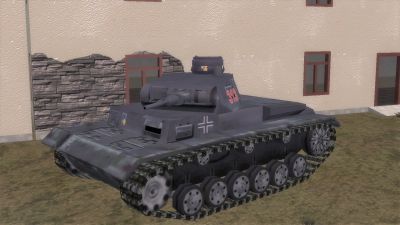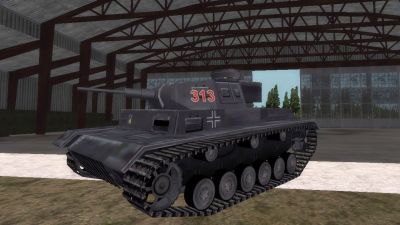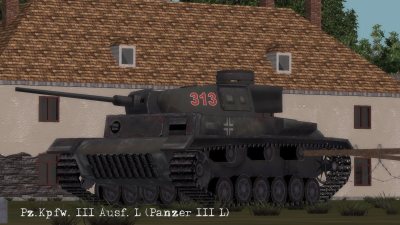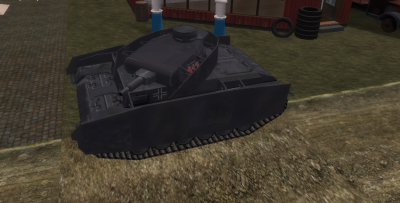Difference between revisions of "PzKpfw III"
| (3 intermediate revisions by the same user not shown) | |||
| Line 126: | Line 126: | ||
{| class="wikitable floatright" | {| class="wikitable floatright" | ||
| colspan="2" | [[File: | | colspan="2" | [[File:Panzer III H sights.png|400px]] | ||
|- style="background:#666600; color:#fff;" | |- style="background:#666600; color:#fff;" | ||
| colspan="2" style="text-align: center;" | '''Main Gun Optics''' | | colspan="2" style="text-align: center;" | '''Main Gun Optics''' | ||
| Line 200: | Line 200: | ||
==History== | ==History== | ||
{| class="wikitable floatright" | {| class="wikitable floatright" | ||
| colspan="2" |[[File:PZ III L.png]] | | colspan="2" |[[File:PZ III L.png|400px]] | ||
|- style="background:#666600; color:#fff;" | |- style="background:#666600; color:#fff;" | ||
| colspan="2" style="text-align: center;" | '''PzKpfw III Ausf. L''' | | colspan="2" style="text-align: center;" | '''PzKpfw III Ausf. L''' | ||
| Line 221: | Line 221: | ||
|} | |} | ||
{| class="wikitable floatright" | {| class="wikitable floatright" | ||
| colspan="2" | [[File: | | colspan="2" | [[File:PanzerIII L sights.png|400px]] | ||
|- style="background:#666600; color:#fff;" | |- style="background:#666600; color:#fff;" | ||
| colspan="2" style="text-align: center;" | '''Main Gun Optics''' | | colspan="2" style="text-align: center;" | '''Main Gun Optics''' | ||
| Line 238: | Line 238: | ||
==Game Play== | ==Game Play== | ||
Instantly recognizable by its prominent main gun barrel, the Ausführung L is the ultimate Panzer Ill. With a gun that delivers as much punch as the Pak 38, a relatively small silhouette and decent speed, the PZ Ill L is more than a match for its contemporary adversaries. However, do not over-rate the capability of your front armour to defeat large calibre armour-piercing shot. Bring out on a flank instead and it will slice through anything at normal engagement ranges. Be advised that its side armour is still as weak as its predecessors, so keep your own flanks secure and do not overstay your welcome. | Instantly recognizable by its prominent main gun barrel, the Ausführung L is the ultimate Panzer Ill. With a gun that delivers as much punch as the Pak 38, a relatively small silhouette and decent speed, the PZ Ill L is more than a match for its contemporary adversaries. However, do not over-rate the capability of your front armour to defeat large calibre armour-piercing shot. Bring out on a flank instead and it will slice through anything at normal engagement ranges. Be advised that its side armour is still as weak as its predecessors, so keep your own flanks secure and do not overstay your welcome. | ||
=PzKpfw III Ausf. N= | =PzKpfw III Ausf. N= | ||
| Line 268: | Line 264: | ||
{| class="wikitable floatright" | {| class="wikitable floatright" | ||
| colspan="2" | [[File: | | colspan="2" | [[File:Panzer III N sights.png|400px]] | ||
|- style="background:#666600; color:#fff;" | |- style="background:#666600; color:#fff;" | ||
| colspan="2" style="text-align: center;" | '''Main Gun Optics''' | | colspan="2" style="text-align: center;" | '''Main Gun Optics''' | ||
Latest revision as of 22:55, 11 August 2021
PzKpfw III Ausf. F
History
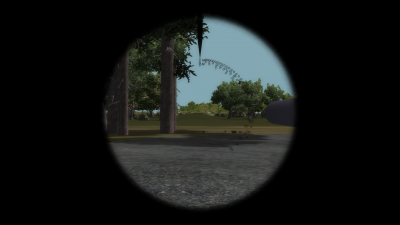
| |
| Main Gun Optics | |
| Specifications | |
| Designation | TZF 5a |
| Magnification | 2.5x |
| Field of View | 25° |
Article 171, paragraph three of the Treaty of Versailles stipulates: "Germany is likewise forbidden to manufacture or import armoured vehicles, tanks, or similar machines which may be turned to military use."
As a result, Germany developed the first prototype vehicles of the Panzerkampfwagen III secretly, at first under the auspicious name of Mittlerer Traktor (Medium Tractor) and later officially as the Zugfuhrerwagen (Platoon-Leader Vehicle). The initial requirement specified a weight of approximately 10 tonnes and armament of a 2cm cannon. The Heereswaffenamt (Army Weapons Branch) evaluated several foreign tank designs and, with direct input from General Oswald Lutz and Heinz Guderian, decided to develop a vehicle that straddled the light and medium classes of tank.
The final specification, although termed a “light tank”, called for an approximately 15-tonne vehicle armed with a 3,7cm cannon. Guderian and Lutz agreed to the 3,7cm-cannon requirement as long as the turret ring would have sufficient diameter to allow for the recoil of a 5cm gun. This would turn out to be an extremely wise and inspired decision.
In 1935, the Heereswaffenamt ordered prototype vehicles from four companies: Daimler-Benz; Krupp; Maschinenfabrik-Augsburg-Neurnberg AG (MAN); and Rheinmetall-Borsig. The prototypes were extensively tested in 1936-37 at the Kummersdorf and Ulm testing grounds and in spring 1937, Daimler-Benz won the contract to produce the first of the PzKpfw III series. The developmental PzKpfw III models carried 15mm armor, upgraded to 30 mm in the Ausf. D, E, and F. They carried the 3.7cm Kampfwagenkanone (Fighting Vehicle Cannon, KwK) 36 L/46.5 gun, essentially the same gun as the PaK 35/36.
Production of the PzKpfw III was initially painfully slow and gaps in the Panzer divisions’ strength were filled with Czechoslovakian PzKpfw 35(t) and PzKpfw 38(t) vehicles. Designers worked primarily on the suspension, and tried several leaf-spring suspension schemes before finalizing the torsion-bar suspension on the Ausf. E. The E model also gained an enhanced Maybach HL 120 TR 300hp engine along with a new Maybach Variorex pre-selector gearbox. This provided ten forward and one reverse gears. Weight increased to 20 tonnes but so did the vehicle's top speed, to a healthy 40km/h.
The Ausf. E was the first variant of significant production with 96 built. The early Ausf. F carried the 3,7cm gun and mounted three 7,92mm MG 34s, two coaxial and one on the bow. Turrets of the later Ausf. F models bore a 5cm gun and one coaxial machine gun. In the chassis, the Ausf. F differed from the Ausf. E only in the addition of ventilation ducts for the track brakes. A total of 435 Ausf. Fs rolled off the assembly line.
The PzKpfw III saw only limited action in Poland in September 1939 but it would fight on every front of the war through late 1943. It was Germany’s first true main/medium battle tank and formed the bulk of the Panzer divisions’ strength during the early years of World War II, especially during the invasion of western Europe. Its adaptable chassis was the foundation of the StuG III long after the PzKpfw III ceased to be a viable tank on the battlefield.
The PzKpfw III gained a reputation for reliability and effectiveness and, despite a gun that lacked punch, it shaped the development plans of both German and Allied tank designers. The Allies quickly recognized that the layout of the vehicle and the incorporation of transverse torsion bar suspension were significant steps forward in tank design. Allied engineers copied the suspension from captured German equipment and incorporated it into the design of vehicles such as the M18 Hellcat, M24 Chaffee, and M26 Pershing.
Game Play
The PzKpfw III Ausf. F is the archetypal German medium tank and its characteristics are representative of the early Panzer advantages over their opponents: speed; reliability; good handling in a variety of terrains; and outstanding optics that enabled precise fire from long ranges. Not a supertank, it suffers typical weaknesses of the period, such as thin armor (especially compared to French tanks), a weak gun, and a total lack of camouflage, which makes it stand out in daylight just about everywhere but urban centers.
The PzKpfw III Ausf. F is a good tank when handled with competence - but that's true of almost any tank. Don’t try to engage anything but light or lightish medium opponents from the front. Use your superior vision and mobility to keep on their flanks. An excellent suspension system makes it easy to fire while moving. Most of all, be patient enough to hold fire until you have a good shot. This is a tactical doctrine which is essential in many other tanks; it’s just smart tanking to do this always.
Your commander is only useful if he’s able to see – leave him unbuttoned so that he can scan at long range with binoculars. This will reveal enemy tanks and let you maneuver around them, out of sight, for that valuable surprise rear or side flank shot that your smallish 37mm main gun requires for a kill. Remember to button if there's any enemy rifles or machine guns in range.
Allied tank and anti-tank guns represent a significant threat to you, like they do to most early-war German armor.
For most early days of a Battleground Europe campaign, the PzKpfw III Ausf. F is the mainstay of Axis tank play because it handles well, is relatively fast over most terrain, and packs two coaxial machine guns instead of the more common single installation. The PzKpfw 38(t) has a superior main gun but isn’t as "sexy" or as popular as this tank tends to be.
Armor
| Location | Thickness | Angle |
|---|---|---|
| Hull front | 30 mm | 21° |
| Hull sides | 30 mm | 0° |
| Hull rear | 21 mm | 10° |
| Hull top | 16 mm | 90° |
| Superstructure front | 30 mm | 9° |
| Superstructure sides | 30 mm | 0° |
| Superstructure rear | 21 mm | 29° |
| Superstructure top | 17 mm | 90° to 77° |
| Turret front | 30 mm | 15° |
| Turret sides | 30 mm | 25° |
| Turret rear | 30 mm | 21° to 0° |
| Turret top | 12 mm | 90° to 83° |
| Gun mantlet | 30 mm | round |
PzKpfw III Ausf. H
History
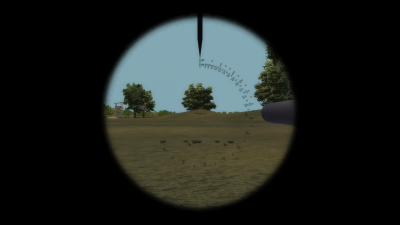
| |
| Main Gun Optics | |
| Specifications | |
| Designation | TZF 5a |
| Magnification | 2.5x |
| Field of View | 25° |
Oswald Luck and Heinz Guderian foresaw the obsolescence of the 3,7cm Kw.K. 36 L / 46,5 cannon and demanded that the PzKpfw III incorporate a larger than required turret ring.
The diameter of a turret ring directly correlates with the momentum it can absorb and the size and power of cannon it can support. By insisting that the PzKpfw III take a larger turret ring than necessary for the weak KwK 36, Luck and Guderian helped create a tank that could later be upgunned. Contrast this with the philosophy behind the design of the Matilda, which, because of its narrow turret ring, could not upgrade to an anti-tank gun beyond its initial 2pdr (although some Matildas later took short 75mm howitzers on board).
Early in the Ausf. F production run, this foresight led to results as the platform adopted the 5cm Kw.K. 38 L / 42 cannon, a substantial upgrade in anti-tank capability. The Ausf. G introduced a new commander's cupola along with a storage bin called a Rommelkiste (Rommel Box) on the rear turret. Some were modified for service in North Africa with felt filters and larger radiators. Some Ausf. Gs still used the 3,7cm gun. The 5cm gun only became a standard with the introduction of the PzKpfw III Ausf. H.
The Ausf. H had a strengthened transverse torsion-bar suspension system with wider tracks, sprockets, and idlers. It weighed more than previous variants, not least due to its additional armour plate. Driving was simplified somewhat with an Aphon synchromesh gear box which provided six forward and one reverse gears.
Harder hitting and able to take a bit more punishment, this revision to the now venerable PzKpfw III granted it new life on the battlefield. The armor upgrades to the front and rear hull facings made some of the approach angles now impenetrable to the ubiquitous British 2pdr anti-tank gun. While the 5cm Kw.K. 38 L / 42 boasted more lethality than the earlier 3,7cm gun, it still struggled against the heavier enemy tanks of the period like the Matilda.
These later variants achieved fame in the desert battles of North Africa, as they could finally fight toe-to-toe against British medium tanks. Elsewhere, the Ausf. H was made instantly obsolete by the surprise of the Soviet T-34, with which it could not trade shots - nor could the PzKpfw III take aboard a gun big enough to do so.
The Ausf. J tried, with a long 5cm gun, the 5cm Kw.K. 39 L / 60, and in fact the J became the most produced variant. Yet the last gun fitted to the line was the same style gun fitted to so many other obsolete tank designs: a short 7,5cm for assault work. Production ceased in August 1943 but the chassis continued life in the StuG line.
Game Play
Recognizable in profile from the earlier PzKpfw III Ausf. F by the extended turret bustle, necessary for installation of the much larger 5cm gun, the Ausf. H is seductive to almost all Axis tankers in Battleground Europe. It represents the first well-armored German tank in the field and packs easily the best anti-tank gun when it's usually introduced. Take care, though - it’s possible to be lulled into a false sense of security by the 2pdr rounds that bounce off your mantlet while you waste the lighter Allied tanks with apparent ease.
Certainly, the 5cm gun is more lethal than the earlier 3,7cm, and combined with the characteristically superior German sights this means that the Ausf. H can be extremely effective compared with its ancestors with lighter guns and armor. But your bigger gun remains unable to penetrate the front of the heaver Allied tanks like the Matilda and B1 bis, and your own thicker armor is biased to front and rear. Your sides and turret remain as thin-skinned as those of your immediate predecessor, the Ausf. F.
This tank is quite good at overwatch duty. Sit at the rear of a wedge or reversed-wedge formation, and use you expanded range and lethality to engage targets of opportunity as they are revealed by the advancing assault guns of more heavily armored AFVs. The StuG IIIB plays that role well early in the rotation.
As in the Ausf. F, leave your commander where he can scan at a distance. Distance is your friend in the Ausf. H. You do not want to get into a close-range knife fight that degrades the advantages of a longer ranging gun and improved armor. Look around and protect your flanks from the numerous 2pdr and 47mm guns that can penetrate your side.
Armor
| Location | Thickness | Angle |
|---|---|---|
| Hull front | 30+30 mm | 21° |
| Hull sides | 30 mm | 0° |
| Hull rear | 30+30 mm | 8° |
| Hull top | 16 mm | 90° |
| Superstructure front | 30+30 mm | 9° |
| Superstructure sides | 30 mm | 0° |
| Superstructure rear | 30 mm | 30° |
| Superstructure top | 17 mm | 90° to 77° |
| Turret front | 30 mm | 13° |
| Turret sides | 30 mm | 25° |
| Turret rear | 30 mm | 13° |
| Turret top | 10 mm | 90° to 85° |
| Gun mantlet | 37 mm | 45° to 0° |
PzKpfw III Ausf. L
History
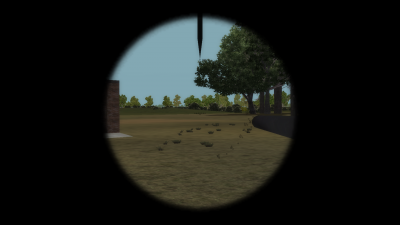
| |
| Main Gun Optics | |
| Specifications | |
| Designation | TZF 5a |
| Magnification | 2.5x |
| Field of View | 25° |
Due to the increased obsolescence of the lighter smaller guns that Panzer III were equipped with, attempts to equip Panzer III with guns from PZ IV however this attempts failed. This lead continued to the production of the Pz.Kpfw. III light tank, The Pz.Kpfw. III light tank, Ausf. L was a reworked Pz.Kpfw. III light tank, Ausf. J. improvements to the Ausf L included increasing the armour on the turret front from 30 mm to 57 mm, installing a torsion-bar counter-balance instead of a coil spring for the main gun, and altering the air-intake louvres and hatches on the rear deck alongside the placement of a 5 cm KwK39 L/60 that packed a bigger punch that the lighter guns found on previous Panzer III.
Game Play
Instantly recognizable by its prominent main gun barrel, the Ausführung L is the ultimate Panzer Ill. With a gun that delivers as much punch as the Pak 38, a relatively small silhouette and decent speed, the PZ Ill L is more than a match for its contemporary adversaries. However, do not over-rate the capability of your front armour to defeat large calibre armour-piercing shot. Bring out on a flank instead and it will slice through anything at normal engagement ranges. Be advised that its side armour is still as weak as its predecessors, so keep your own flanks secure and do not overstay your welcome.
PzKpfw III Ausf. N
History
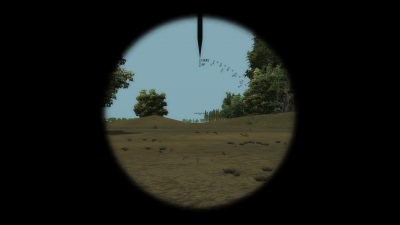
| |
| Main Gun Optics | |
| Specifications | |
| Designation | TZF 5a |
| Magnification | 2.5x |
| Field of View | 25° |
The Ausf.N, mounted a short-barrel 7.5 cm Kampfwagenkanone 37 L/24 (7.5 cm KwK 37 L/24) tank gun, previously used on the Panzer IV. It was a low-velocity tank gun that was designed to fire mainly high explosive shells. If it had to engage armoured vehicles in combat it could fire the Panzergranate armour-piercing AP shell, but it was only effective at short ranges. Later on in the war, crews had the option to load the new 7.5 cm HL-granaten 39 hollow-charge high-explosive anti-tank HEAT projectiles which had a greater effect against tank armour. The Panzer III Ausf.N was increasingly used in the infantry support role once the 75 mm long barrelled Panzer IV, Panther and 88mm armed Tiger tank entered service.
Starting in May 1943 Schürzen 5 mm skirt armour plates were mounted on the hull side and 10 mm plates on the turret, to prevent the Soviet 14.5 mm anti-tank rifle penetrating the side armour of the Panzer III
Game Play
The PZ III N excels at close support for infantry and for other more capable panzers. Use its machine-guns and heavy load of 75 mm HE to pave a way for infantry and its HEAT shell to defeat any enemy tank from the side or rear at right angles. Remember also that despite the awesome looking schurzen your armour protection is still mostly for show rather than effect - except from the front where additional armour may shrug off a round or two.
